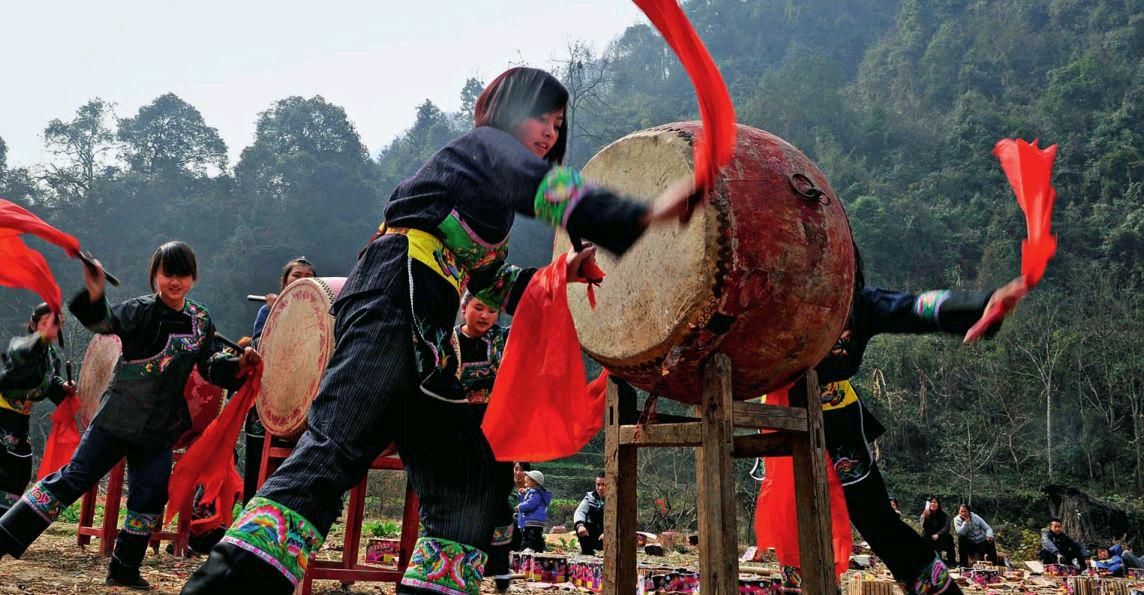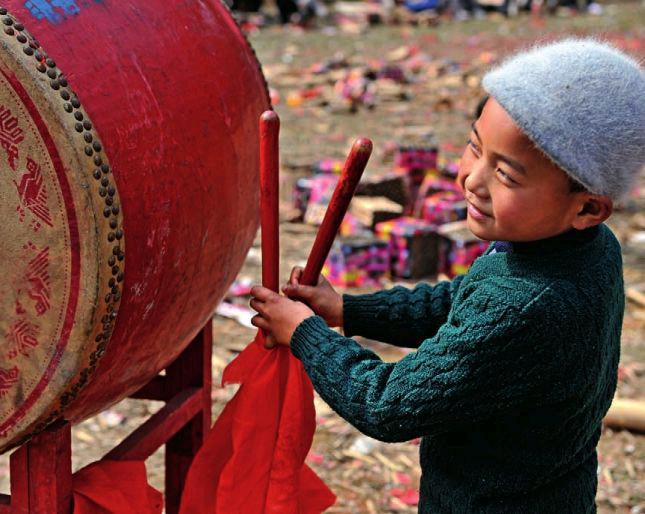Miao Drum Dancer Shi Shunmin:The Beat Goes on
By+staff+reporter+JIAO+FENG
GROWING up in the mountains of Jishou, Shi Shunmin never dreamed her drum dance performances would one day become a cultural asset, representing her people and history.
Miao drum dancing, whose origins are in sacrifi -cial rituals, was traditionally performed in Guizhou, Hunan and other provinces with a high Miao population. But with modern civilization wiping out old norms and customs en masse, it has lost much of its luster among the younger generations.
When Shi was a child, there were very few people learning drum dancing. But when one day she saw her mother dance, she fell in love with the art and danced her way out of the mountains.
In Shis home, there is a photo that catches every visitors attention: Mao Zedong and Zhou Enlai stand among notable representatives of Chinas ethnic groups, including Shi. The photo commemorates Shis fi rst performance at the Great Hall of the People in Beijing. Whenever she recalls that day, her heart swells with pride.
First Encounters
Shi was born into a rural family of meager means. At the age of eight, she recalls, her neighbor held a bull sacrificial ceremony to drive out evil spirits. People gathered around a fi re, beating drums, singing and dancing the whole night.
Shi can still recall the scenes of that night. With every beat of the drum, more and more Miao people gather around the fi re; two Miao women dance while beating the big, red-lacquered drum; they turn, jump, tilt their heads, bend right back, contort their bodies. Shis mother was one of the two drummers. From that night, Shi became infatuated with the dance and started to learn from her mother.
That was a time of endless imagination. As she didnt own a drum and drumstick, Shi improvised with whatever she could fi nd – a canister made of newspaper, the wall, the rungs of a wooden ladder. In her eyes, anything could be a drum and any place could serve as her stage.
Year in, year out, Shi spent her spare time drum dancing, come rain or shine. Whether after mowing grass in the morning, after school in the afternoon, or after cleaning up at night, Shi was always full of energy and enthusiasm for dancing. Her diligence and talent contributed to her mature dancing technique, which singled her out from other local dancers.
Dancing to Beijing
Intending no disrespect to her mother, her teacher, Shi felt that her dancing skills had, essentially, been fostered “in the wild.” Striving for more,Shi attended first Jishou County Dance and Drama School, then the Peking Opera Troupe of Xiangxi Tujia and Miao Autonomous Prefecture for professional training. By the end of her education she had acquired more dancing skills and learned kung fu. With these, she could perform the Miao drum dance to perfection.
In 1964, aged just 15, Shi was invited to Beijings Great Hall of the People for a joint performance of national ethnic group troupes. She remembered that her teams Miao drum dance received three rounds of thundering applause from the ebullient audience. And after the performance, as a Miao performer representative, she met with Chinas top leaders including Chairman Mao Zedong and Premier Zhou Enlai.
Now, 48 years have passed, but Shi still remembers vividly the moment Chairman Mao shook her hand.
Since then, Shi has been fully committed to dancing. The definitive drum dancing queen, Shi is a winner of many national and regional dance awards. “I can skip food, but I could never skip beating the drum, its a part of my life,” Shi said.
Discovering Life through Dance
“In Miao drum dancing, many movements are related to everyday life and farming, aspects central to Miao culture, such as plowing fields, harvesting crops, personal grooming and embroidering,” Shi explained. With one hand beating the drum, she passes the other by her head, mimicking combing the hair; a bending movement symbolizes spinning; twisting fingers and raising the forearm represents embroidery; other day-to-day activities such as digging, sowing seeds and harvesting are also symbolically acted out through dance. In several minutes, daily work scenes of the Miao people are vividly revealed.
A central instrument in ancient sacrificial ceremonies and wars of the Miao people, the drum was the dancing totem of their tribes, revealing their spirit and soul. Their migration from north to south scattered Miao tribes, but whenever they heard the beat of the Miao drum, they would understand its implicit meaning.
Over the years, Shi has added many modern elements to traditional Miao drum dancing, enhancing its rhythmic beats and distinctive features as well as its choreographic complexity, so appealing to the greater public.
Dancing On
Shi sees it as her responsibility to carry on this beautiful, time-honored art form for future generations.
In 2004, Shi retired from her job at the local cultural center. She opened a Miao drum dancing class in her backyard offering free lessons. When she was younger, Shi was taken by the thrill of performing on the stage; but by 2004, she was more interested in channeling her time and energy toward fostering new inheritors of the art form.
At first glance, the makeshift studio in Shis backyard is a rather crude environment for such a beautiful dance. It has the necessities – a dozen huge, crimson drums and two big mirrors on opposing walls – but also holes in the ceiling. Yet this doesnt worry Shi. It doesnt stop students from coming to her; as Shi proudly reminded us, notable drum dancers of younger generations, such as Long Junlan and Long Jupei, have all come out of Shis dance studio. As her students pass the art to others, people who have learned from her directly or indirectly now number close to 10,000. They work for 180-odd Miao drum troupes.
But Shi is not satisfied with the current scope of drum dancings influence and is striving to do even more for this heritage. In order to involve more and more people in her love of drum dancing, Shi and her students travel to middle and primary schools in remote areas to teach. Shi said, “Our lessons are free, and we teach students until they can do it at will.” Shi also plans to produce instructional videos according to the types and schools of Miao drum dancing to encourage even more people beyond the borders of Xiangxi and even China to learn.
Her mission is gaining momentum. Today, women sporting traditional Miao silver headwear and costumes performing the dance on street corners and squares is a common sight in Jishou. When they move, the sweet tinkling of their silver trimmings accompanies the drumbeat. It should remind you what Shi Shunmin has done to pass on this graceful art.

